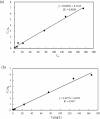Study on the adsorption of Pb2+ in aqueous solution by alkali modified wheat bran
- PMID: 40592876
- PMCID: PMC12216198
- DOI: 10.1038/s41598-025-03876-x
Study on the adsorption of Pb2+ in aqueous solution by alkali modified wheat bran
Abstract
Due to human activities such as mining, metal smelting, and sewage irrigation, a significant amount of heavy metals have entered the environment, exacerbating the problem of heavy metal pollution in water bodies. The study of rapid adsorption and removal of lead is particularly critical due to its slow degradation and severe environmental impact. In this study, wheat bran was utilized as an adsorbent and modified using a sodium hydroxide solution. Kinetic and equilibrium adsorption studies were conducted to evaluate the adsorption performance of alkali modified wheat bran on lead ions in water. The adsorption behavior and mechanism of alkali modified wheat bran on Pb2+ were analyzed from three perspectives: time, concentration, and pH, in conjunction with surface functional groups and microscopic characteristics. The results indicated that the adsorption capacity of alkali modified wheat bran was achieved at pH 4, a concentration of 100 mg/L, and an duration of approximately 120 min. Experimental data shows that at about 120 min, its adsorption efficiency reaches its peak at 81.74%. The fitting results of the adsorption kinetics model and isothermal adsorption model indicate that the adsorption of modified wheat bran is characterized by single-layer chemical adsorption; The alkaline modification treatment increased the porosity of the surface pores of wheat bran, resulting in a rougher surface and an enhanced adsorption area. Furthermore, post-modification, the wheat bran exhibited increased C-H and C = O functional groups, thereby improving the adsorption of Pb2+.
Keywords: Adsorption; Alkali modification; Lead ion; Wheat Bran.
© 2025. The Author(s).
Conflict of interest statement
Declarations. Competing interests: The authors declare no competing interests.
Figures








Similar articles
-
Utilization of Tommy Atkins Mango Peel as a Sustainable Biosorbent for the Removal of Pb(II) Ions in Water.Chem Biodivers. 2025 Jul;22(7):e202403209. doi: 10.1002/cbdv.202403209. Epub 2025 Apr 15. Chem Biodivers. 2025. PMID: 40063665
-
Enhanced and efficient capture of Cd(II) through functionalized metal-organic frameworks embedded in a biopolymer (carboxymethyl cellulose/polyethylenimine): Thermodynamics, kinetics, and optimization via Box-Behnken methodology.Int J Biol Macromol. 2025 Jul;318(Pt 1):144903. doi: 10.1016/j.ijbiomac.2025.144903. Epub 2025 Jun 4. Int J Biol Macromol. 2025. PMID: 40473180
-
Adsorptive removal of lead from wastewater using pressmud with evaluation of kinetics and adsorption isotherms.Sci Rep. 2025 Jul 2;15(1):22823. doi: 10.1038/s41598-025-05169-9. Sci Rep. 2025. PMID: 40594468 Free PMC article.
-
Modification Strategies of Kapok Fiber Composites and Its Application in the Adsorption of Heavy Metal Ions and Dyes from Aqueous Solutions: A Systematic Review.Int J Environ Res Public Health. 2022 Feb 25;19(5):2703. doi: 10.3390/ijerph19052703. Int J Environ Res Public Health. 2022. PMID: 35270400 Free PMC article.
-
A systematic review on adsorptive removal of hexavalent chromium from aqueous solutions: Recent advances.Sci Total Environ. 2022 Feb 25;809:152055. doi: 10.1016/j.scitotenv.2021.152055. Epub 2021 Dec 4. Sci Total Environ. 2022. PMID: 34871684
References
-
- Wang, C. et al. Impact of coking plant to heavy metal characteristics in groundwater of surrounding areas: Spatial distribution, source apportionment and risk assessments. J. Environ. Sci.149, 688–698 (2025). - PubMed
-
- Elumalai, S., Prabhu, K., Selvan, G. P. & Ramasamy, P. Review on heavy metal contaminants in freshwater fish in South India: current situation and future perspective. Environ. Sci. Pollut R. 30, 119594–119611 (2023). - PubMed
-
- Wang, X., Hu, X., Chen, Y. J. & Liu, Y. Adsorption and fixation of heavy metals in water environment by Biochar and modified Biochar. Environ. Eng.34, 32–37 (2016).
-
- Park, J. H., Choppala, G. K., Bolan, N. S., Chung, J. W. & Chuasavathi, T. Biochar reduces the bioavailability and phytotoxicity of heavy metals. Plant. Soil.348, 439–451 (2011).
-
- Wang, B. Y., Zhu, Y. E. & Li, H. Effects of vinegar residue Biochar on Pb (II) adsorption in water. Environ. Eng.34, 6–11 (2016).
MeSH terms
Substances
Grants and funding
LinkOut - more resources
Full Text Sources
Medical

